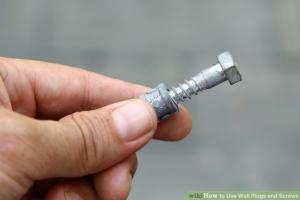Mastering Wall Plugs and Screws: The Ultimate Guide for DIY Enthusiasts

-
Quick Links:
- Introduction
- What Are Wall Plugs?
- Types of Wall Plugs
- Choosing the Right Wall Plug
- What Are Screws?
- Types of Screws
- Choosing the Right Screw
- How to Install Wall Plugs and Screws
- Common Mistakes to Avoid
- Real-World Case Studies
- Expert Insights
- FAQs
Introduction
Wall plugs and screws are essential components in the world of DIY and home improvement. Whether you're hanging a picture frame, mounting a shelf, or installing a heavy appliance, knowing how to properly use wall plugs and screws is crucial for ensuring safety and longevity. This guide aims to provide you with comprehensive insights into the types of wall plugs and screws available, their uses, and step-by-step instructions on how to install them effectively.
What Are Wall Plugs?
Wall plugs, also known as anchors, are devices used to secure screws in walls or ceilings. They create a sturdy point for screws to hold onto, ensuring that the fixtures are securely attached to the wall.
Types of Wall Plugs
- Plastic Wall Plugs: Commonly used for lightweight items.
- Metal Wall Plugs: Ideal for heavier loads; they expand when a screw is inserted.
- Toggle Bolts: Best for hollow walls, providing strong support.
- Self-Drilling Wall Plugs: These can be installed without pre-drilling a hole.
Choosing the Right Wall Plug
Choosing the appropriate wall plug depends on the weight of the object being mounted and the type of wall surface.
- If you're hanging a picture frame, a standard plastic wall plug may suffice.
- For heavier items like shelves, consider metal wall plugs or toggle bolts for added strength.
What Are Screws?
Screws are fasteners that hold materials together. They are available in various sizes, types, and materials, making them versatile for numerous applications.
Types of Screws
- Wood Screws: Designed for use in wood; they have a coarse thread.
- Machine Screws: Used with nuts or in tapped holes.
- Self-Tapping Screws: Can create their own hole as they are driven into the material.
- Sheet Metal Screws: Used for fastening metal sheets together.
Choosing the Right Screw
When selecting screws, consider the material you are fastening, the load it will bear, and the environment (e.g., moisture resistance).
How to Install Wall Plugs and Screws
Follow these step-by-step instructions to effectively install wall plugs and screws:
- Gather Your Tools: You will need a drill, wall plugs, screws, a screwdriver, and a level.
- Determine Your Mounting Location: Use a level to mark where you want to place the item.
- Drill a Hole: Use a drill bit that matches the size of the wall plug. Drill into the wall at the marked location.
- Insert the Wall Plug: Push the wall plug into the hole until it is flush with the wall.
- Attach the Screw: Insert the screw into the wall plug and tighten it using a screwdriver.
Common Mistakes to Avoid
- Using the wrong size wall plug or screw.
- Forgetting to drill a pilot hole for larger screws.
- Not ensuring the wall plug is securely installed before attaching the screw.
Real-World Case Studies
In a recent project, a homeowner attempted to install a heavy shelf using only plastic wall plugs. The shelf collapsed under the weight because the plugs were not suitable for the load. By switching to toggle bolts, the shelf was successfully mounted and has held its weight for over a year without issues.
Expert Insights
According to construction expert John Smith, “Understanding the materials you are working with is crucial for a successful installation. Always opt for a wall plug and screw that can support your intended load.”
FAQs
- Q: Can I use wall plugs in drywall?
A: Yes, but ensure to use the appropriate type of wall plug, like toggle bolts, for heavier items. - Q: How do I know if a wall plug is suitable for my screw?
A: Check the packaging; it usually indicates the screw size that fits. - Q: Can wall plugs be removed and reused?
A: Generally, wall plugs are designed for single use; removing them may damage the wall. - Q: What size drill bit should I use for wall plugs?
A: Use a drill bit that matches the diameter of the wall plug. - Q: Are there wall plugs specifically for outdoor use?
A: Yes, there are weather-resistant wall plugs suitable for outdoor applications. - Q: How much weight can wall plugs support?
A: This varies by type; check manufacturer specifications for weight limits. - Q: What if the wall plug spins in the hole?
A: It may be a sign of an oversized hole; you may need a larger wall plug or to fill the hole. - Q: Can I use wall plugs in concrete?
A: Yes, but use masonry wall plugs designed specifically for concrete. - Q: Is it necessary to use a wall plug for light items?
A: For lightweight items, a screw directly into a stud may suffice, but a wall plug adds security. - Q: Can wall plugs be used with all types of screws?
A: No, ensure the screw type is compatible with the wall plug chosen.
Random Reads